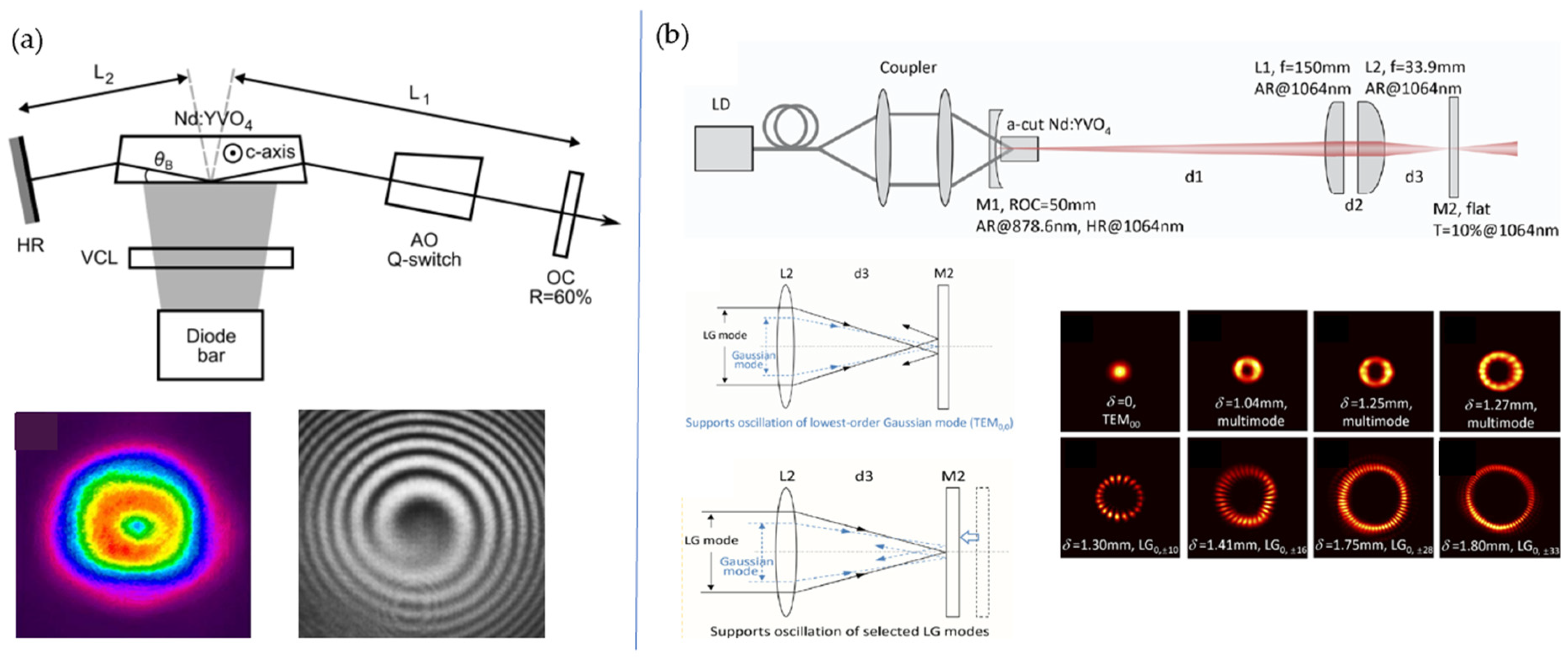Advances on Solid-State Vortex Laser
Abstract
:1. Introduction
2. Vortex Lasers from Intra-Cavity Modulation
2.1. Annular Pumping
2.2. Off-Axis Pumping
2.3. Defect Mirror
2.4. Intra-Cavity Modulation Devices
2.4.1. Digital Laser
2.4.2. Q-Plate
2.4.3. Metasurface
2.5. Others
3. Conclusions
Funding
Institutional Review Board Statement
Informed Consent Statement
Data Availability Statement
Conflicts of Interest
References
- Forbes, A.; Dudley, A.; McLaren, M. Creation and detection of optical modes with spatial light modulators. Adv. Opt. Photonics 2016, 8, 200–227. [Google Scholar]
- Strickland, D.; Mourou, G. Compression of amplified chirped optical pulses. Opt. Commun. 1985, 55, 447–449. [Google Scholar]
- Fu, S.Y.; Han, X.; Song, R.; Huang, L.; Gao, C.Q. Generating a 64 × 64 beam lattice by geometric phase modulation from arbitrary incident polarizations. Opt. Lett. 2020, 45, 6330–6333. [Google Scholar] [PubMed]
- Fu, S.Y.; Wang, T.L.; Zhang, Z.Y.; Zhai, Y.W.; Gao, C.Q. Selective acquisition of multiple states on hybrid Poincare sphere. Appl. Phys. Lett. 2017, 110, 191102. [Google Scholar]
- Fu, S.Y.; Gao, C.Q.; Wang, T.L.; Zhang, S.K.; Zhai, Y.W. Simultaneous generation of multiple perfect polarization vortices with selective spatial states in various diffraction orders. Opt. Lett. 2016, 41, 5454–5457. [Google Scholar]
- Chang, G.Q.; Wei, Z.Y. Ultrafast Fiber Lasers: An Expanding Versatile Toolbox. Iscience 2020, 23, 101101. [Google Scholar]
- Liu, W.J.; Liu, M.L.; Chen, X.; Shen, T.; Lei, M.; Guo, J.G.; Deng, H.X.; Zhang, W.; Dai, C.Q.; Zhang, X.F.; et al. Ultrafast photonics of two dimensional AuTe2Se4/3 in fiber lasers. Commun. Phys. 2020, 3, 15. [Google Scholar]
- Gori, F.; Guattari, G.; Padovani, C. Bessel-Gauss beams. Opt. Commun. 1987, 64, 491–495. [Google Scholar]
- Efremidis, N.K.; Chen, Z.G.; Segev, M.; Christodoulides, D.N. Airy beams and accelerating waves: An overview of recent advances. Optica 2019, 6, 686–701. [Google Scholar]
- Zhuang, J.L.; Zhang, L.P.; Deng, D.M. Tight-focusing properties of linearly polarized circular Airy Gaussian vortex beam. Opt. Lett. 2020, 45, 296–299. [Google Scholar]
- Zhan, Q.W. Cylindrical vector beams: From mathematical concepts to applications. Adv. Opt. Photonics 2009, 1, 828–891. [Google Scholar]
- Shen, Y.J.; Yang, X.L.; Naidoo, D.; Fu, X.; Forbes, A. Structured ray-wave vector vortex beams in multiple degrees of freedom from a laser. Optica 2020, 7, 820–831. [Google Scholar]
- Wang, Z.Y.; Shen, Y.J.; Naidoo, D.; Fu, X.; Forbes, A. Astigmatic hybrid SU(2) vector vortex beams: Towards versatile structures in longitudinally variant polarized optics. Opt. Express 2021, 29, 315–329. [Google Scholar] [PubMed]
- Allen, L.; Beijersbergen, M.W.; Spreeuw, R.J.C.; Woerdman, J.P. Orbital angular-momentum of light and the transformation of Laguerre-Gaussian laser modes. Phys. Rev. A 1992, 45, 8185–8189. [Google Scholar] [PubMed]
- Bai, Y.; Lv, H.; Fu, X.; Yang, Y. Vortex beam: Generation and detection of orbital angular momentum. Chin. Opt. Lett. 2022, 20, 012601. [Google Scholar]
- Zhou, H.; Yang, J.Q.; Gao, C.Q.; Fu, S.Y. High-efficiency, broadband all-dielectric transmission metasurface for optical vortex generation. Opt. Mater. Express 2019, 9, 2806. [Google Scholar]
- Zhang, J.; Sun, C.Z.; Xiong, B.; Wang, J.; Hao, Z.B.; Wang, L.; Han, Y.J.; Li, H.T.; Luo, Y.; Xiao, Y.; et al. An InP-based vortex beam emitter with monolithically integrated laser. Nat. Commun. 2018, 9, 1–6. [Google Scholar]
- Cai, X.L.; Wang, J.W.; Strain, M.J.; Johnson-Morris, B.; Zhu, J.B.; Sorel, M.; O’Brien, J.L.; Thompson, M.G.; Yu, S.T. Integrated Compact Optical Vortex Beam Emitters. Science 2012, 338, 363–366. [Google Scholar]
- Yang, Y.; Zhao, Q.; Liu, L.; Liu, Y.; Rosales-Guzman, C.; Qiu, C.-W. Manipulation of Orbital-Angular-Momentum Spectrum Using Pinhole Plates. Phys. Rev. Appl. 2019, 12, 064007. [Google Scholar]
- Zeng, R.; Zhao, Q.; Shen, Y.; Liu, Y.; Yang, Y. Structural stability of open vortex beams. Appl. Phys. Lett. 2021, 119, 171105. [Google Scholar]
- Wang, J.; Yang, J.Y.; Fazal, I.M.; Ahmed, N.; Yan, Y.; Huang, H.; Ren, Y.; Yue, Y.; Dolinar, S.; Tur, M.; et al. Terabit free-space data transmission employing orbital angular momentum multiplexing. Nat. Photonics 2012, 6, 488–496. [Google Scholar]
- Bozinovic, N.; Yue, Y.; Ren, Y.; Tur, M.; Kristensen, P.; Huang, H.; Willner, A.E.; Ramachandran, S. Terabit-Scale Orbital Angular Momentum Mode Division Multiplexing in Fibers. Science 2013, 340, 1545–1548. [Google Scholar] [PubMed] [Green Version]
- Yu, S. Potentials and challenges of using orbital angular momentum communications in optical interconnects. Opt. Express 2015, 23, 3075–3087. [Google Scholar] [PubMed]
- Willner, A.E.; Huang, H.; Yan, Y.; Ren, Y.; Ahmed, N.; Xie, G.; Bao, C.; Li, L.; Cao, Y.; Zhao, Z.; et al. Optical communications using orbital angular momentum beams. Adv. Opt. Photonics 2015, 7, 66–106. [Google Scholar]
- Wang, J. Advances in communications using optical vortices. Photonics Res. 2016, 4, B14–B28. [Google Scholar]
- Fu, S.; Zhai, Y.; Zhou, H.; Zhang, J.; Yin, C.; Gao, C. Demonstration of high-dimensional free-space data coding/decoding through multi-ring optical vortices. Chin. Opt. Lett. 2019, 17, 080602. [Google Scholar]
- Fu, S.; Zhai, Y.; Zhou, H.; Zhang, J.; Wang, T.; Yin, C.; Gao, C. Demonstration of free-space one-to-many multicasting link from orbital angular momentum encoding. Opt. Lett. 2019, 44, 4753–4756. [Google Scholar]
- Fu, S.; Zhai, Y.; Zhou, H.; Zhang, J.; Wang, T.; Liu, X.; Gao, C. Experimental demonstration of free-space multi-state orbital angular momentum shift keying. Opt. Express 2019, 27, 33111–33119. [Google Scholar]
- Lavery, M.P.J.; Speirits, F.C.; Barnett, S.M.; Padgett, M.J. Detection of a Spinning Object Using Light’s Orbital Angular Momentum. Science 2013, 341, 537–540. [Google Scholar]
- Lavery, M.P.J.; Barnett, S.M.; Speirits, F.C.; Padgett, M.J. Observation of the rotational Doppler shift of a white-light, orbital-angular-momentum-carrying beam backscattered from a rotating body. Optica 2014, 41, 2549–2552. [Google Scholar]
- Fu, S.; Wang, T.; Zhang, Z.; Zhai, Y.; Gao, C. Non-diffractive Bessel-Gauss beams for the detection of rotating object free of obstructions. Opt. Express 2017, 25, 20098–20108. [Google Scholar] [PubMed]
- Fang, L.; Padgett, M.J.; Wang, J. Sharing a Common Origin Between the Rotational and Linear Doppler Effects. Laser Photonics Rev. 2017, 11, 1700183. [Google Scholar]
- Zhang, W.; Gao, J.; Zhang, D.; He, Y.; Xu, T.; Fickler, R.; Chen, L. Free-Space Remote Sensing of Rotation at the Photon-Counting Level. Phys. Rev. Appl. 2018, 10, 044014. [Google Scholar]
- Zhai, Y.; Fu, S.; Yin, C.; Zhou, H.; Gao, C. Detection of angular acceleration based on optical rotational Doppler effect. Opt. Express 2019, 27, 15518–15527. [Google Scholar] [PubMed]
- Qiu, S.; Liu, T.; Ren, Y.; Li, Z.; Wang, C.; Shao, Q. Detection of spinning objects at oblique light incidence using the optical rotational Doppler effect. Opt. Express 2019, 27, 24781–24792. [Google Scholar]
- Zhai, Y.; Fu, S.; Zhang, J.; Lv, Y.; Zhou, H.; Gao, C. Remote detection of a rotator based on rotational Doppler effect. Appl. Phys. Express 2020, 13, 022012. [Google Scholar]
- Padgett, M.; Bowman, R. Tweezers with a twist. Nat. Photonics 2011, 5, 343–348. [Google Scholar]
- Chen, M.; Mazilu, M.; Arita, Y.; Wright, E.M.; Dholakia, K. Dynamics of microparticles trapped in a perfect vortex beam. Opt. Lett. 2013, 38, 4919–4922. [Google Scholar]
- Gecevicius, M.; Drevinskas, R.; Beresna, M.; Kazansky, P.G. Single beam optical vortex tweezers with tunable orbital angular momentum. Appl. Phys. Lett. 2014, 104, 231110. [Google Scholar]
- Liang, Y.; Yao, B.; Ma, B.; Lei, M.; Yan, S.; Yu, X. Holographic Optical Trapping and Manipulation Based on Phase-only Liquid-Crystal Spatial Light Modulator. Acta Opt. Sin. 2016, 36, 0309001–0309007. [Google Scholar]
- Yang, Y.; Ren, Y.-X.; Chen, M.; Arita, Y.; Rosales-Guzman, C. Optical trapping with structured light: A review. Adv. Photonics 2021, 3, 034001. [Google Scholar]
- Rosales-Guzman, C.; Ndagano, B.; Forbes, A. A review of complex vector light fields and their applications. J. Opt. 2018, 20, 123001. [Google Scholar]
- Fu, S.Y.; Hai, L.; Song, R.; Gao, C.Q.; Zhang, X.D. Representation of total angular momentum states of beams through a four-parameter notation. New J. Phys. 2021, 23, 083015. [Google Scholar]
- Kagalwala, K.H.; Di Giuseppe, G.; Abouraddy, A.F.; Saleh, B.E.A. Bell’s measure in classical optical coherence. Nat. Phys. 2013, 7, 72–78. [Google Scholar]
- Ndagano, B.; Bruening, R.; McLaren, M.; Duparre, M.; Forbes, A. Fiber propagation of vector modes. Opt. Express 2015, 23, 17330–17336. [Google Scholar]
- Berg-Johansen, S.; Toeppel, F.; Stiller, B.; Banzer, P.; Ornigotti, M.; Giacobino, E.; Leuchs, G.; Aiello, A.; Marquardt, C. Classically entangled optical beams for high-speed kinematic sensing. Optica 2015, 2, 864–868. [Google Scholar]
- Rafsanjani, S.M.H.; Mirhosseini, M.; Magana-Loaiza, O.S.; Boyd, R.W. State transfer based on classical nonseparability. Phys. Rev. A 2015, 92, 023827. [Google Scholar]
- Harris, J.; Grillo, V.; Mafakheri, E.; Gazzadi, G.C.; Frabboni, S.; Boyd, R.W.; Karimi, E. Structured quantum waves. Nat. Phys. 2015, 11, 629–634. [Google Scholar]
- Bandyopadhyay, P.; Basu, B.; Chowdhury, D. Relativistic Electron Vortex Beams in a Laser Field. Phys. Rev. Lett. 2015, 115, 194801. [Google Scholar]
- Niziev, V.G.; Nesterov, A.V. Influence of beam polarization on laser cutting efficiency. J. Phys. D 1999, 32, 1455–1461. [Google Scholar]
- Meier, M.; Romano, V.; Feurer, T. Material processing with pulsed radially and azimuthally polarized laser radiation. Appl. Phys. A 2007, 86, 329–334. [Google Scholar]
- Zhao, W.Q.; Tang, F.; Qiu, L.R.; Liu, D.L. Research status and application on the focusing properties of cylindrical vector beams. Acta Phys. Sin. 2013, 62, 054201. [Google Scholar]
- Zhou, Z.; Tan, Q.; Jin, G. Surface plasmon interference formed by tightly focused higher polarization order axially symmetric polarized beams. Chin. Opt. Lett. 2010, 8, 1178–1181. [Google Scholar]
- Wang, X.; Nie, Z.; Liang, Y.; Wang, J.; Li, T.; Jia, B. Recent advances on optical vortex generation. Nanophononics 2018, 7, 1533–1556. [Google Scholar]
- Forbes, A. Structured Light from Lasers. Laser Photonics Rev. 2019, 13, 1900140. [Google Scholar]
- Shen, Y.; Wang, X.; Xie, Z.; Min, C.; Fu, X.; Liu, Q.; Gong, M.; Yuan, X. Optical vortices 30 years on: OAM manipulation from topological charge to multiple singularities. Light Sci. Appl 2019, 8, 1–29. [Google Scholar]
- Liu, Q.; Pan, J.; Wan, Z.; Shen, Y.; Zhang, H.; Fu, X.; Gong, M. Generation Methods for Complex Vortex Structured Light Field. Chin. J. Lasers 2020, 47, 0500006. [Google Scholar]
- Beijersbergen, M.W.; Allen, L.; Vanderveen, H.; Woerdman, J.P. Astigmatic laser mode converters and transfer of orbital angular-momentum. Opt. Commun. 1993, 96, 123–132. [Google Scholar]
- Malyutin, A.A.; Ilyukhin, V.A. Generation of high-order Hermite-Gaussian modes in a flashlamp-pumped neodymium phosphate glass laser and their conversion to Laguerre-Gaussian modes. Quantum Electron. 2007, 37, 181–186. [Google Scholar]
- Beijersbergen, M.W.; Coerwinkel, R.P.C.; Kristensen, M.; Woerdman, J.P. Helical-wave-front laser beams produced with a spiral phaseplate. Opt. Commun. 1994, 112, 321–327. [Google Scholar]
- Turnbull, G.A.; Robertson, D.A.; Smith, G.M.; Allen, L.; Padgett, M.J. Generation of free-space Laguerre-Gaussian modes at millimetre-wave frequencies by use of a spiral phaseplate. Opt. Commun. 1996, 127, 183–188. [Google Scholar]
- Xin, J.; Dai, K.; Zhong, L.; Na, Q.; Gao, C. Generation of optical vortices by using spiral phase plates made of polarization dependent devices. Opt. Lett. 2014, 39, 1984–1987. [Google Scholar] [PubMed]
- Xiong, M.; Ding, P.; Pu, J. Analysis on the Beam Characteristic of Gaussian Beam Passing Multi-Level Spiral Phase Plate. Laser Optoelectron. Prog. 2015, 52, 081902. [Google Scholar]
- Guo, M.; Zeng, J.; Li, J. Generation and Interference of Vortex Beam Based on Spiral Phase Plate. Laser Optoelectron. Prog. 2016, 53, 092602. [Google Scholar]
- Heckenberg, N.R.; McDuff, R.; Smith, C.P.; White, A.G. Generation of optical-phase singularities by computer-generated holograms. Opt. Lett. 1992, 17, 221–223. [Google Scholar]
- Davis, J.A.; McNamara, D.E.; Cottrell, D.M.; Campos, J. Image processing with the radial Hilbert transform: Theory and experiments. Opt. Lett. 2000, 25, 99–101. [Google Scholar]
- Guo, C.S.; Liu, X.; Ren, X.Y.; Wang, H.T. Optimal annular computer-generated holograms for the generation of optical vortices. J. Opt. Soc. Am. A 2005, 22, 385–390. [Google Scholar]
- Sun, J.; Wang, X.; Xu, T.; Kudyshev, Z.A.; Cartwright, A.N.; Litchinitser, N.M. Spinning Light on the Nanoscale. Nano Lett. 2014, 14, 2726–2729. [Google Scholar]
- Mehmood, M.Q.; Mei, S.; Hussain, S.; Huang, K.; Siew, S.Y.; Zhang, L.; Zhang, T.; Ling, X.; Liu, H.; Teng, J.; et al. Visible-Frequency Metasurface for Structuring and Spatially Multiplexing Optical Vortices. Adv. Mater. 2016, 28, 2533. [Google Scholar]
- Devlin, R.C.; Ambrosio, A.; Rubin, N.A.; Mueller, J.P.B.; Capasso, F. Arbitrary spin-to-orbital angular momentum conversion of light. Science 2017, 358, 896–900. [Google Scholar]
- Zhang, Y.; Liu, W.; Gao, J.; Yang, X. Generating Focused 3D Perfect Vortex Beams by Plasmonic Metasurfaces. Adv. Opt. Mater. 2018, 6, 1701228. [Google Scholar]
- Ren, Y.X.; Li, M.; Huang, K.; Wu, J.G.; Gao, H.F.; Wang, Z.Q.; Li, Y.-M. Experimental generation of Laguerre-Gaussian beam using digital micromirror device. Appl. Opt. 2010, 49, 1838–1844. [Google Scholar] [PubMed]
- Mirhosseini, M.; Magana-Loaiza, O.S.; Chen, C.; Rodenburg, B.; Malik, M.; Boyd, R.W. Rapid generation of light beams carrying orbital angular momentum. Opt. Express 2013, 21, 30196–30203. [Google Scholar] [PubMed] [Green Version]
- Chen, Y.; Fang, Z.X.; Ren, Y.X.; Gong, L.; Lu, R.D. Generation and characterization of a perfect vortex beam with a large topological charge through a digital micromirror device. Appl. Opt. 2015, 54, 8030–8035. [Google Scholar]
- Ji, W.; Lee, C.H.; Chen, P.; Hu, W.; Ming, Y.; Zhang, L.; Lin, T.H.; Chigrinov, V.; Lu, Y.-Q. Meta-q-plate for complex beam shaping. Sci. Rep. 2016, 6, 25528. [Google Scholar]
- Fu, S.; Gao, C.; Shi, Y.; Dai, K.; Zhong, L.; Zhang, S. Generating polarization vortices by using helical beams and a Twyman Green interferometer. Opt. Lett. 2015, 40, 1775–1778. [Google Scholar]
- Wang, T.; Fu, S.; Zhang, S.; Gao, C.; He, F. A Sagnac-like interferometer for the generation of vector beams. Appl. Phys. B 2016, 122, 231. [Google Scholar]
- Fu, S.; Wang, T.; Gao, C. Generating perfect polarization vortices through encoding liquid-crystal display devices. Appl. Opt. 2016, 55, 6501–6505. [Google Scholar]
- Fu, S.; Wang, T.; Gao, C. Perfect optical vortex array with controllable diffraction order and topological charge: Erratum. J. Opt. Soc. Am. A 2016, 33, 2076. [Google Scholar]
- Fu, S.; Zhai, Y.; Wang, T.; Yin, C.; Gao, C. Tailoring arbitrary hybrid Poincare beams through a single hologram. Appl. Phys. Lett. 2017, 111, 211101. [Google Scholar]
- Mao, D.; Zheng, Y.; Zeng, C.; Lu, H.; Wang, C.; Zhang, H.; Zhang, W.; Mei, T.; Zhao, J. Generation of polarization and phase singular beams in fibers and fiber lasers. Adv. Photonics 2021, 3, 014002. [Google Scholar]
- Fu, P.; Ni, P.N.; Wang, Q.H.; Liu, Y.F.; Wu, B.; Chen, P.P.; Kan, Q.; Wang, S.P.; Chen, H.D.; Xu, C.; et al. Multichannel Generations of Orbital Angular Momentum Modes with On-Demand Characteristics on a Chip. Adv. Opt. Mater. 2021, 9, 2101308. [Google Scholar]
- Prati, F.; Tissoni, G.; SanMiguel, M.; Abraham, N.B. Vector vortices and polarization state of low-order transverse modes in a VCSEL. Opt. Commun. 1997, 143, 133–146. [Google Scholar]
- Jimenez-Garcia, J.; Rodriguez, P.; Guillet, T.; Ackemann, T. Spontaneous Formation of Vector Vortex Beams in Vertical-Cavity Surface-Emitting Lasers with Feedback. Phys. Rev. Lett. 2017, 119, 113902. [Google Scholar]
- Wang, K.; Gao, C.; Lin, Z.; Wang, Q.; Gao, M.; Huang, S.; Chen, C. 1645 nm coherent Doppler wind lidar with a single-frequency Er:YAG laser. Opt. Express 2020, 28, 14694–14704. [Google Scholar]
- Stephan, C.; Alpers, M.; Millet, B.; Ehret, G.; Flamant, P.; Deniel, C. MERLIN—A space-based methane monitor. In Proceedings of the Conference on Lidar Remote Sensing for Environmental Monitoring XII, San Diego, CA, USA, 21–22 August 2011. [Google Scholar]
- Chen, Y.F.; Lan, Y.P.; Wang, S.C. Generation of Laguerre-Gaussian modes in fiber-coupled laser diode end-pumped lasers. Appl. Phys. B 2001, 72, 167–170. [Google Scholar]
- Zhao, Y.; Liu, Q.; Zhou, W.; Shen, D. ~1 mJ pulsed vortex laser at 1645 nm with well-defined helicity. Opt. Express 2016, 24, 15596–15602. [Google Scholar]
- Liu, Q.; Zhao, Y.; Zhou, W.; Shen, D. Vortex operation in Er:LuYAG crystal laser at similar to 1.6 μm. Opt. Mater. 2017, 71, 31–34. [Google Scholar]
- Liu, Q.; Zhao, Y.; Ding, M.; Yao, W.; Fan, X.; Shen, D. Wavelength-and OAM-tunable vortex laser with a reflective volume Bragg grating. Opt. Express 2017, 25, 23312–23319. [Google Scholar]
- Liu, Q.; Zhao, Y.; Zhou, W.; Zhang, J.; Wang, L.; Yao, W.; Shen, D. Control of Vortex Helicity With a Quarter-Wave Plate in an Er:YAG Ceramic Solid State Laser. IEEE Photon. J. 2017, 9, 1–8. [Google Scholar]
- Fang, Z.; Yao, Y.; Xia, K.; Li, J. Actively Q-switched and vortex Nd:YAG laser. Opt. Commun. 2015, 347, 59–63. [Google Scholar]
- Fang, Z.; Yao, Y.; Xia, K.; Li, J. Simple Nd:YAG laser generates vector and vortex beam. Chin. Opt. Lett. 2015, 13, 031405. [Google Scholar]
- Kim, J.W. High-power laser operation of the first-order Laguerre-Gaussian (LG01) mode in a diode-laser-pumped Nd:YAG laser. J. Korean Phys. Soc. 2012, 61, 739–743. [Google Scholar]
- Kim, J.W.; Clarkson, W.A. Selective generation of Laguerre-Gaussian (LG0n) mode output in a diode-laser pumped Nd:YAG laser. Opt. Commun. 2013, 296, 109–112. [Google Scholar]
- Kim, D.J.; Kim, J.W.; Clarkson, W.A. Q-switched Nd:YAG optical vortex lasers. Opt. Express 2013, 21, 29449–29454. [Google Scholar]
- Lin, D.; Daniel, J.M.O.; Clarkson, W.A. Controlling the handedness of directly excited Laguerre-Gaussian modes in a solid-state laser. Opt. Lett. 2014, 39, 3903–3906. [Google Scholar]
- Lu, J.; Lin, H.; Zhang, G.; Li, B.; Zhang, L.; Lin, Z.; Chen, Y.F.; Petrov, V.; Chen, W. Direct generation of an optical vortex beam from a diode-pumped Yb:MgWO4 laser. Laser Phys. Lett. 2017, 14, 085807. [Google Scholar]
- Bisson, J.E.; Senatsky, Y.; Ueda, K.I. Generation of Laguerre-Gaussian modes in Nd: YAG laser using diffractive optical pumping. Laser Phys. Lett. 2005, 2, 327–333. [Google Scholar]
- Li, J.; Yao, Y.; Yu, J.; Xia, K.; Zhou, C. Efficient Vortex Laser with Annular Pumping Formed by Circle Dammann Grating. IEEE Photon. 2016, 28, 473–476. [Google Scholar]
- Schepers, F.; Bexter, T.; Hellwig, T.; Fallnich, C. DMD-Based Excitation of Transverse Laser Modes by Spatial Pump Beam Shaping. In Conference on Lasers and Electro-Optics Europe/European Quantum Electronics Conference (CLEO/Europe-EQEC), Munich, Germany, 23–27 June; 2019. [Google Scholar]
- Wei, M.D.; Lai, Y.-S.; Chang, K.C. Generation of a radially polarized laser beam in a single microchip Nd:YVO4 laser. Opt. Lett. 2013, 38, 2443–2445. [Google Scholar]
- He, H.S.; Chen, Z.; Dong, J. Direct generation of vector vortex beams with switchable radial and azimuthal polarizations in a monolithic Nd:YAG microchip laser. Appl. Phys. Express 2017, 10, 052701. [Google Scholar]
- Chen, Y.F.; Huang, T.M.; Kao, C.F.; Wang, C.L.; Wang, S.C. Generation of Hermite-Gaussian modes in fiber-coupled laser-diode end-pumped lasers. IEEE J. Quantum Electron. 1997, 33, 1025–1031. [Google Scholar]
- Laabs, H.; Ozygus, B. Excitation of Hermite Gaussian modes in end-pumped solid-state lasers via off-axis pumping. Opt. Laser Technol. 1996, 28, 213–214. [Google Scholar]
- Chu, S.C.; Ohtomo, T.; Otsuka, K. Generation of doughnutlike vortex beam with tunable orbital angular momentum from lasers with controlled Hermite-Gaussian modes. Appl. Opt. 2008, 47, 2583–2591. [Google Scholar]
- Huang, X.; Xu, B.; Cui, S.; Xu, H.; Cai, Z.; Chen, L. Direct Generation of Vortex Laser by Rotating Induced Off-Axis Pumping. IEEE J. Sel. Top. Quantum Electron. 2018, 24, 1–6. [Google Scholar]
- Wang, S.; Zhang, S.L.; Qiao, H.C.; Li, P.; Hao, M.H.; Yang, H.M.; Xie, J.; Feng, G.Y.; Zhou, S.H. Direct generation of vortex beams from a double-end polarized pumped Yb:KYW laser. Opt. Express 2018, 26, 26925–26932. [Google Scholar]
- Lin, G.; Cao, Y.; Lu, Z.; Chembo, Y.K. Spontaneous generation of orbital angular momentum crystals using a monolithic Nd:YAG nonplanar ring laser. Opt. Lett. 2019, 44, 203–206. [Google Scholar]
- Liu, J.; Lin, J.; Chen, X.; Yu, Y.; Wu, C.; Jin, G. A 1.9 km Tm: YLF external cavity mode conversion vortex laser based on LD off-axis pump. Opt. Commun. 2021, 482, 126596. [Google Scholar]
- Shen, Y.; Meng, Y.; Fu, X.; Gong, M. Wavelength-tunable Hermite-Gaussian modes and an orbital-angular-momentum-tunable vortex beam in a dual-off-axis pumped Yb:CALGO laser. Opt. Lett. 2018, 43, 291–294. [Google Scholar]
- Ito, A.; Kozawa, Y.; Sato, S. Generation of hollow scalar and vector beams using a spot-defect mirror. J. Opt. Soc. Am. A 2010, 27, 2072–2077. [Google Scholar]
- Lee, A.J.; Omatsu, T.; Pask, H.M. Direct generation of a first-Stokes vortex laser beam from a self-Raman laser. Opt. Express 2013, 21, 12401–12408. [Google Scholar] [PubMed]
- Qiao, Z.; Xie, G.; Wu, Y.; Yuan, P.; Ma, J.; Qian, L.; Fan, D. Generating High-Charge Optical Vortices Directly from Laser Up to 288th Order. Laser Photonics Rev. 2018, 12, 1800019. [Google Scholar]
- Zhou, L.; Feng, K.; Wang, D.; Xu, B. Research on direct generation of high-power and high-order vortex lasers using defect-mirror technology. Infrared Laser Eng. 2021, 50, 20210408. [Google Scholar]
- Oron, R.; Danziger, Y.; Davidson, N.; Friesem, A.A.; Hasman, E. Laser mode discrimination with intra-cavity spiral phase elements. Opt. Commun. 1999, 169, 115–121. [Google Scholar]
- Kim, D.J.; Kim, J.W. High-power TEM00 and Laguerre-Gaussian mode generation in double resonator configuration. Appl. Phys. B 2015, 121, 401–405. [Google Scholar]
- Kim, D.J.; Mackenzie, J.I.; Kim, J.W. Adaptable beam profiles from a dual-cavity Nd:YAG laser. Opt. Lett. 2016, 41, 1740–1743. [Google Scholar]
- Ngcobo, S.; Litvin, I.; Burger, L.; Forbes, A. A digital laser for on-demand laser modes. Nat. Commun. 2013, 4, 1–6. [Google Scholar]
- Naidoo, D.; Roux, F.S.; Dudley, A.; Litvin, I.; Piccirillo, B.; Marrucci, L.; Forbes, A. Controlled generation of higher-order Poincare sphere beams from a laser. Nat. Photonics 2016, 10, 327. [Google Scholar]
- Fan, J.; Zhao, J.; Shi, L.; Xiao, N.; Hu, M. Two-channel, dual-beam-mode, wavelength-tunable femtosecond optical parametric oscillator. Adv. Photonics 2020, 2, 045001. [Google Scholar]
- Song, R.; Gao, C.; Zhou, H.; Fu, S. Resonantly pumped Er:YAG vector laser with selective polarization states at 1.6 μm. Opt. Lett. 2020, 45, 4626–4629. [Google Scholar]
- Song, R.; Liu, X.; Fu, S.; Gao, C. Simultaneous tailoring of longitudinal and transverse mode inside an Er:YAG laser. Chin. Opt. Lett. 2021, 19, 111404. [Google Scholar]
- Sroor, H.; Huang, Y.W.; Sephton, B.; Naidoo, D.; Valles, A.; Ginis, V.; Qiu, C.W.; Ambrosio, A.; Capasso, F.; Forbes, A. High-purity orbital angular momentum states from a visible metasurface laser. Nat. Photonics 2020, 14, 498. [Google Scholar]
- Chard, S.P.; Shardlow, P.C.; Damzen, M.J. High-power non-astigmatic TEM00 and vortex mode generation in a compact bounce laser design. Appl. Phys. B 2009, 97, 275–280. [Google Scholar]
- Wang, M.; Ma, Y.; Sheng, Q.; He, X.; Liu, J.; Shi, W.; Yao, J.; Omatsu, T. Laguerre-Gaussian beam generation via enhanced intracavity spherical aberration. Opt. Express 2021, 29, 27783–27790. [Google Scholar] [PubMed]
- Sheng, Q.; Wang, A.H.; Ma, Y.Y.; Wang, S.J.; Wang, M.; Shi, Z.; Liu, J.J.; Fu, S.J.; Shi, W.; Yao, J.Q.; et al. Intracavity spherical aberration for selective generation of single-transverse-mode Laguerre-Gaussian output with order up to 95. Photonix 2022, 3, 4. [Google Scholar]
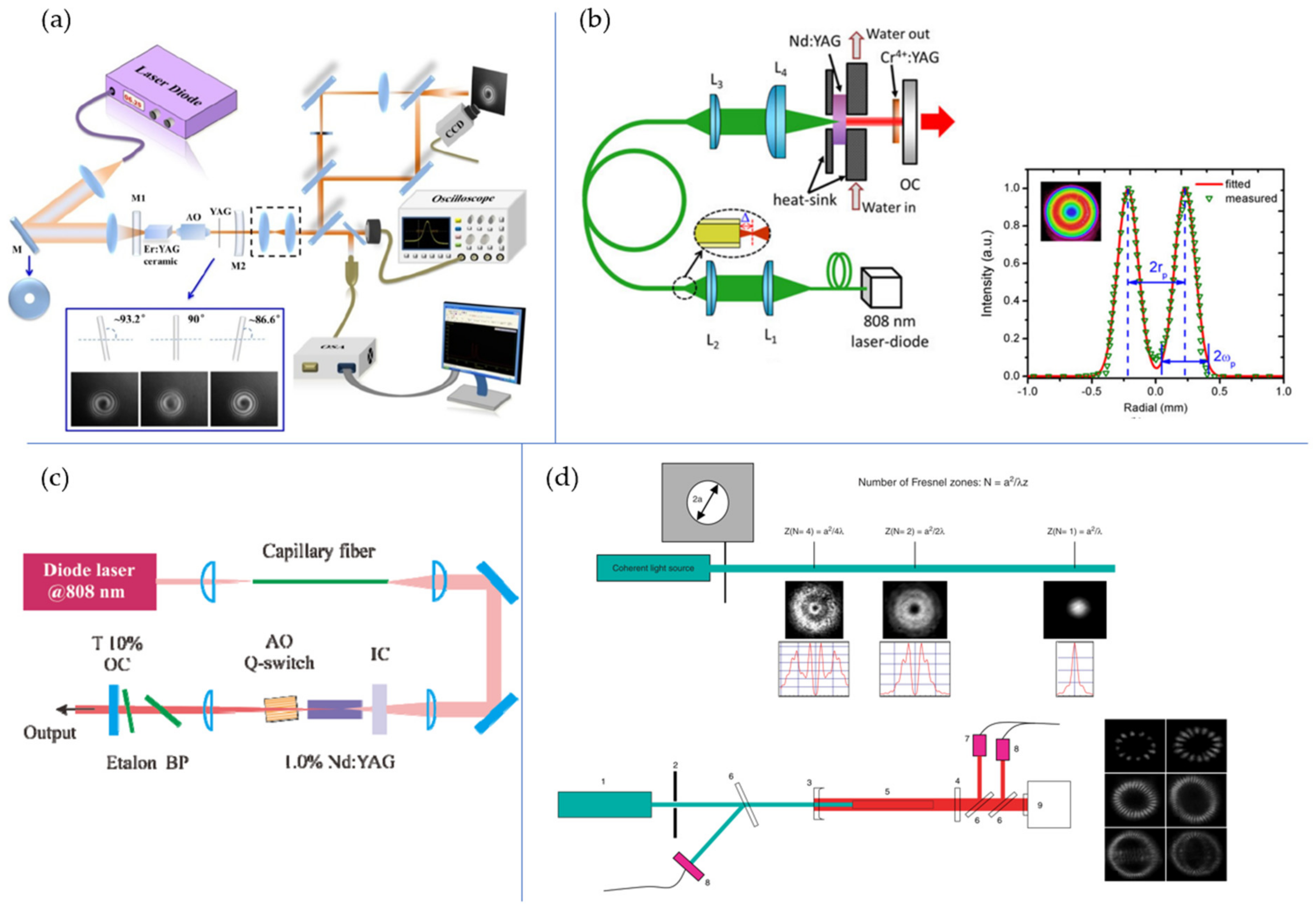
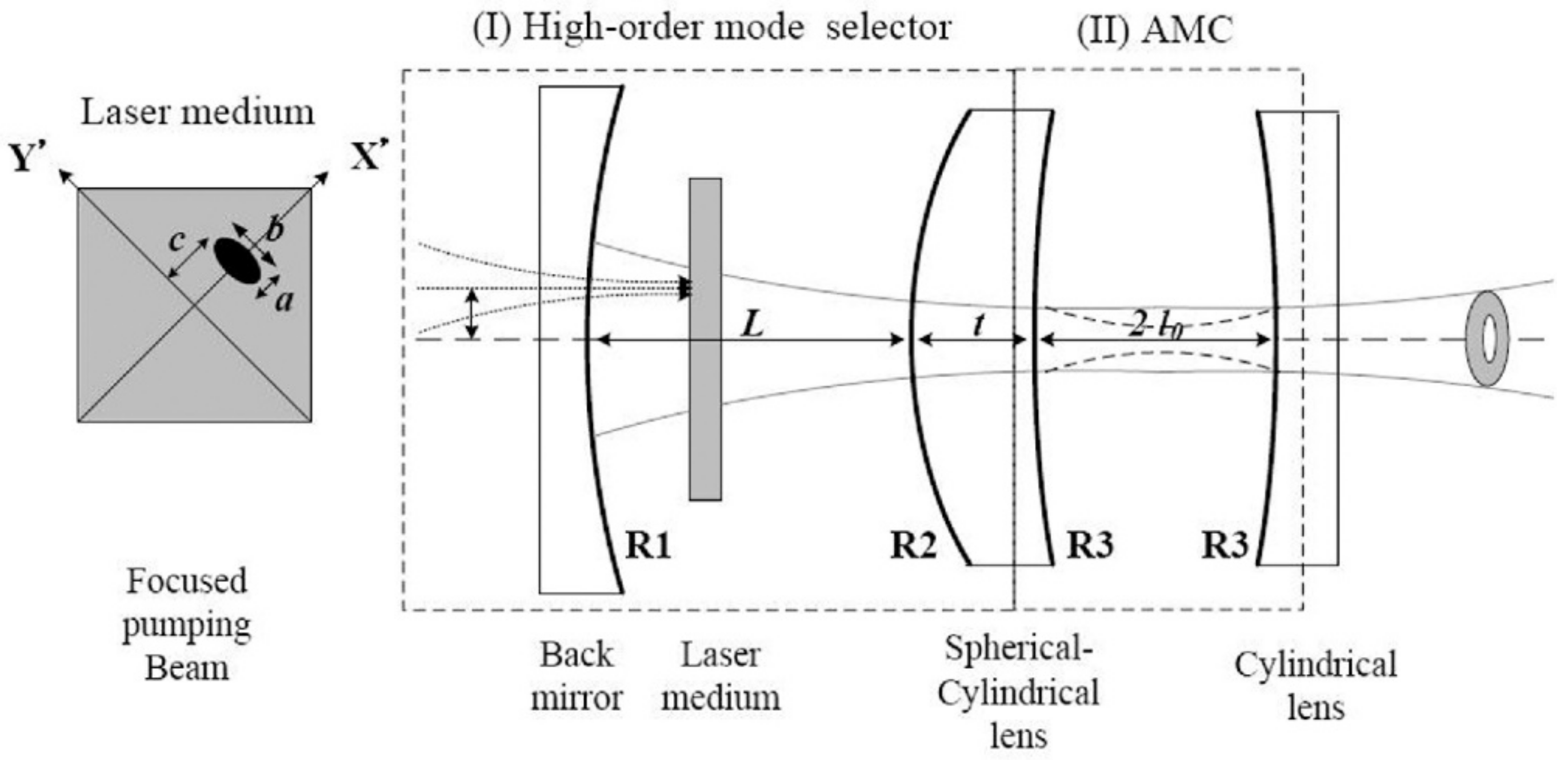
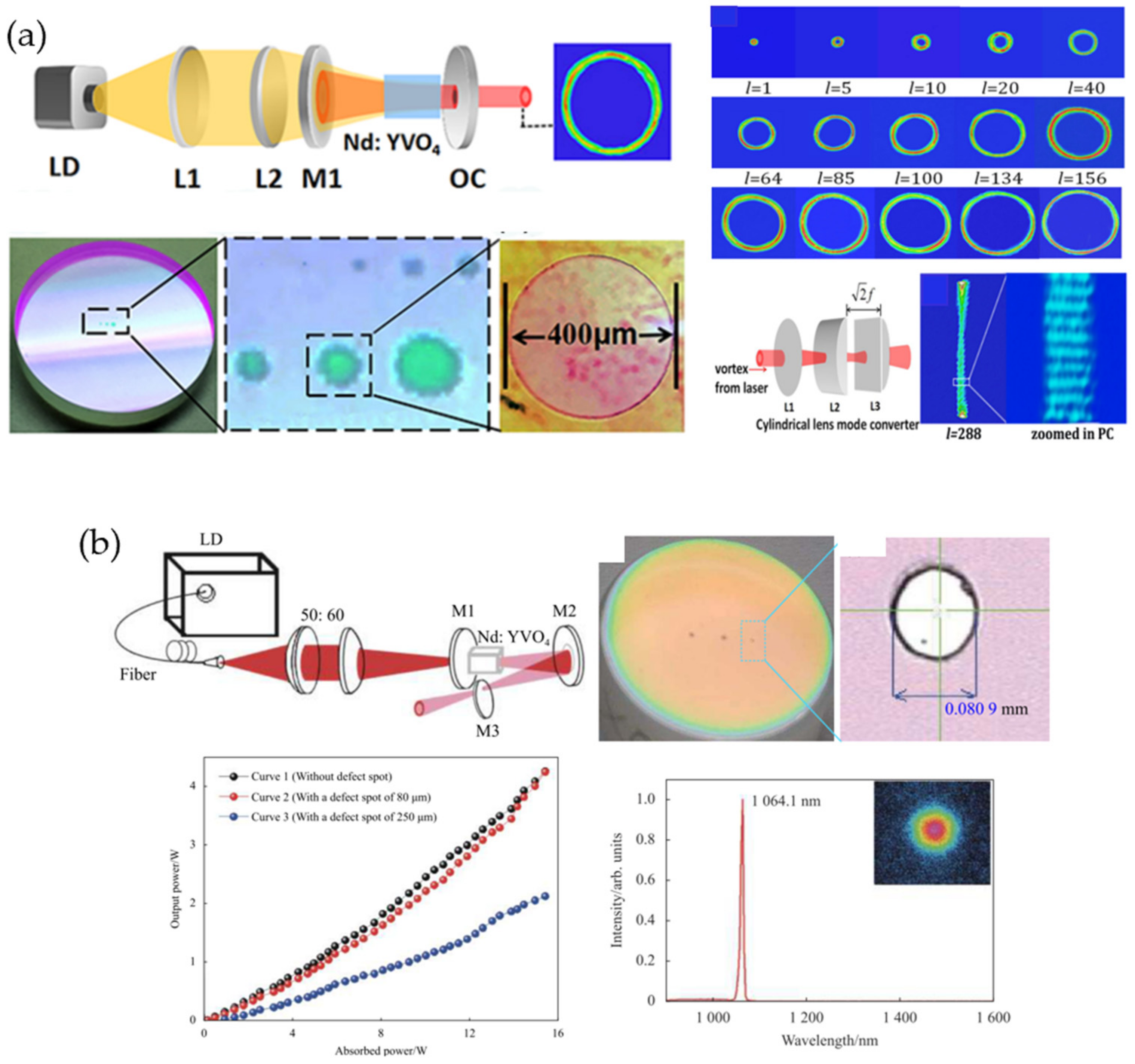


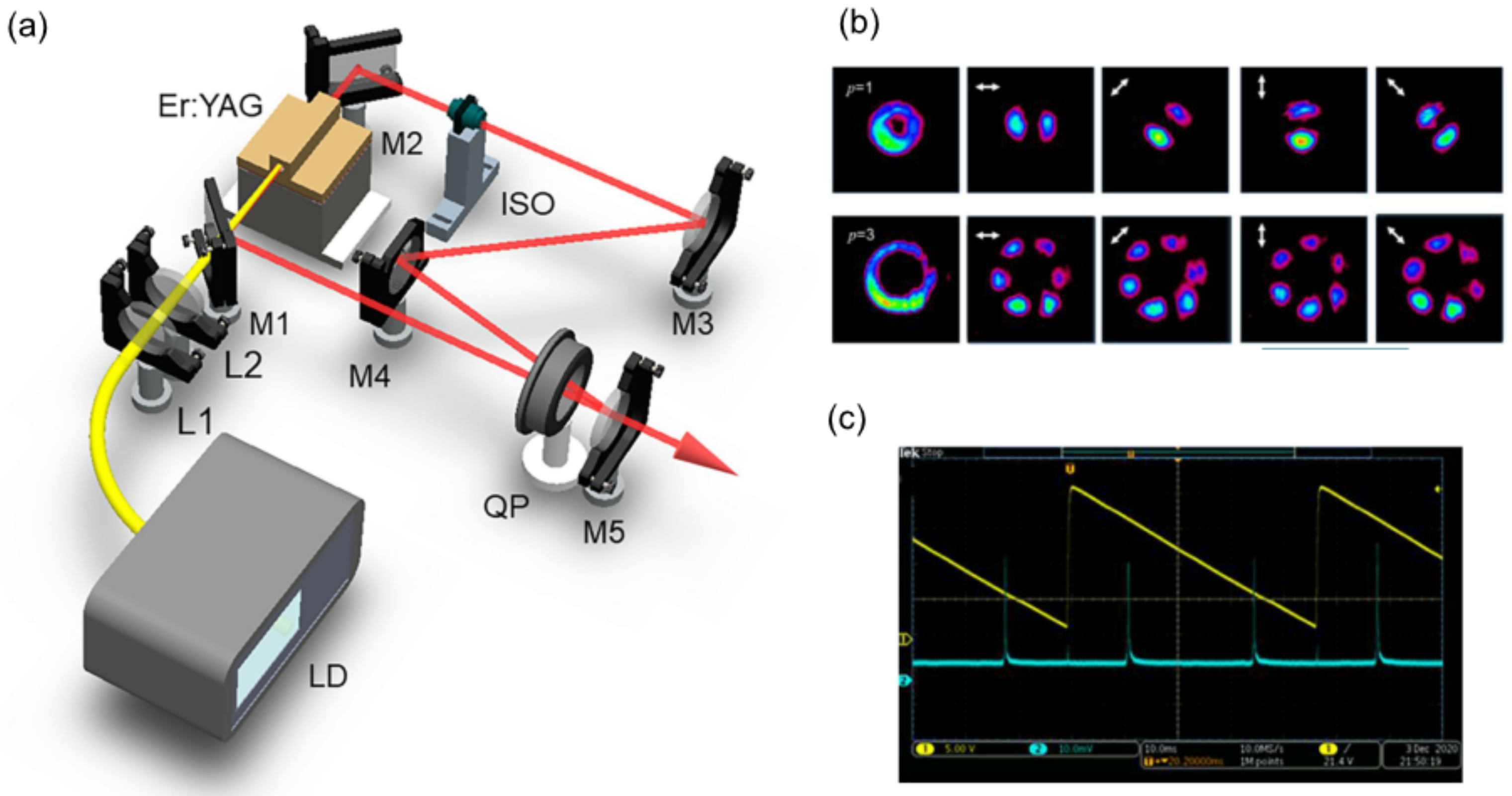
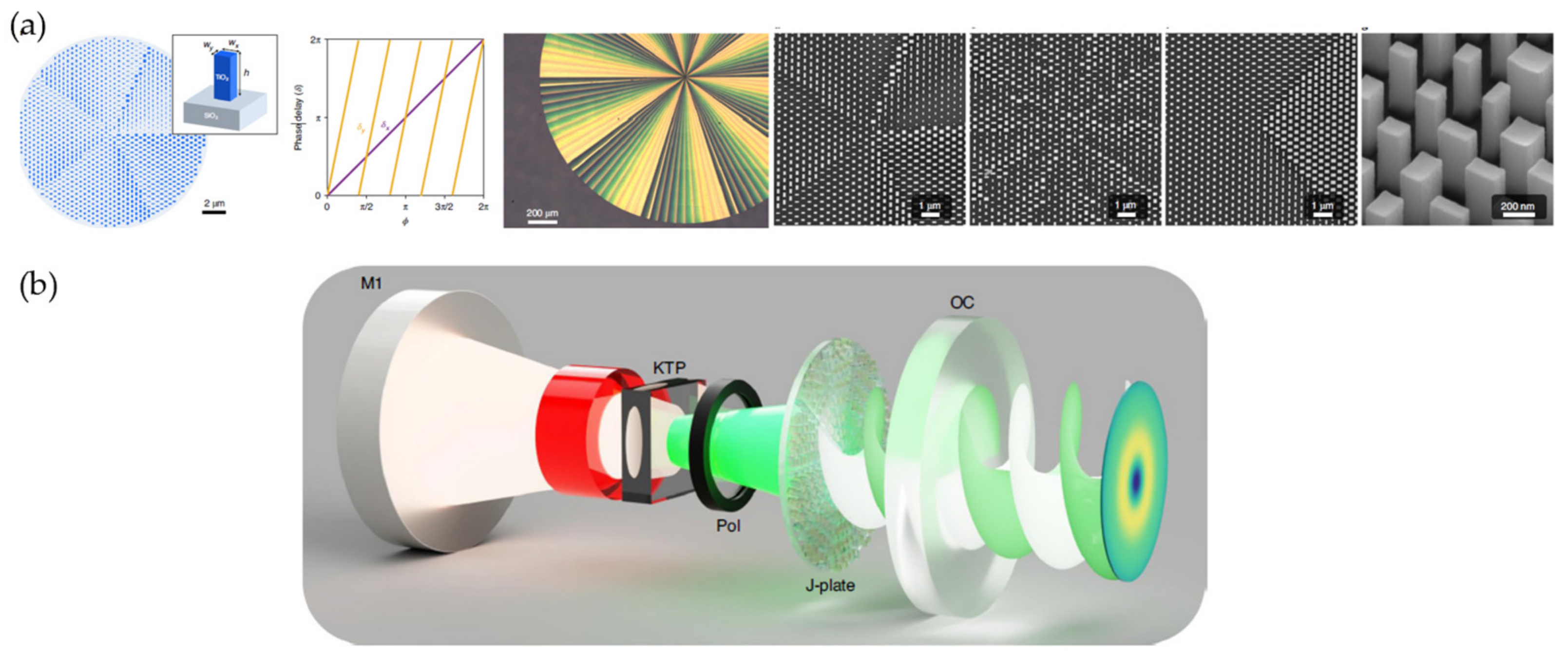
Publisher’s Note: MDPI stays neutral with regard to jurisdictional claims in published maps and institutional affiliations. |
© 2022 by the authors. Licensee MDPI, Basel, Switzerland. This article is an open access article distributed under the terms and conditions of the Creative Commons Attribution (CC BY) license (https://creativecommons.org/licenses/by/4.0/).
Share and Cite
Zhang, Z.; Hai, L.; Fu, S.; Gao, C. Advances on Solid-State Vortex Laser. Photonics 2022, 9, 215. https://doi.org/10.3390/photonics9040215
Zhang Z, Hai L, Fu S, Gao C. Advances on Solid-State Vortex Laser. Photonics. 2022; 9(4):215. https://doi.org/10.3390/photonics9040215
Chicago/Turabian StyleZhang, Zhichao, Lan Hai, Shiyao Fu, and Chunqing Gao. 2022. "Advances on Solid-State Vortex Laser" Photonics 9, no. 4: 215. https://doi.org/10.3390/photonics9040215
APA StyleZhang, Z., Hai, L., Fu, S., & Gao, C. (2022). Advances on Solid-State Vortex Laser. Photonics, 9(4), 215. https://doi.org/10.3390/photonics9040215




